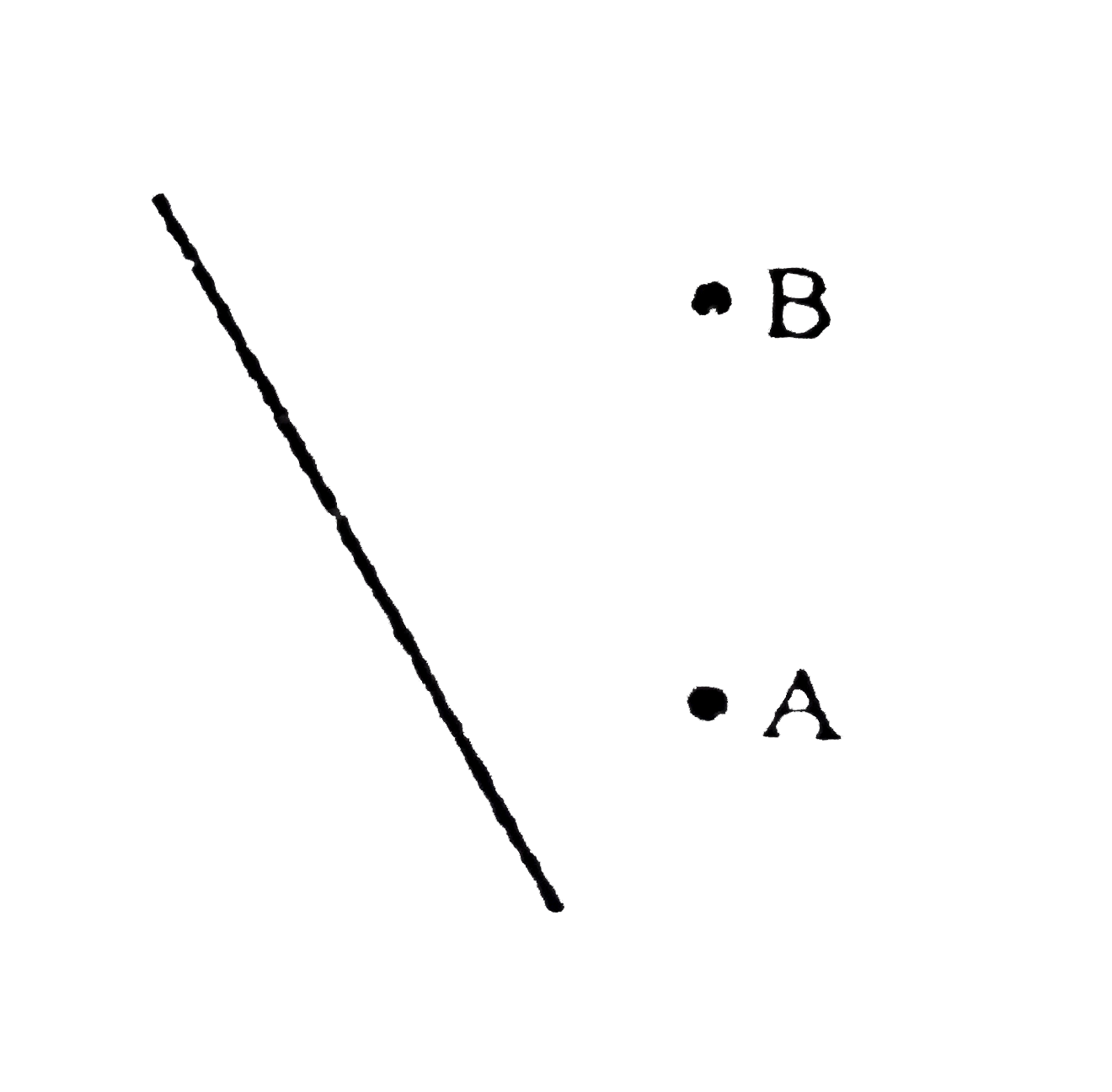Find the potential difference VAB between A(2m,1m,0) and B(0,2m,4m) in an electric field,
E=(xˆi−2yˆj+zˆk)Vm
To find the potential difference VAB between points A(2m,1m,0) and B(0,2m,4m) in the given electric field E=(x^i−2y^j+z^k)V/m, we can follow these steps:
Step 1: Understand the formula for potential difference
The potential difference VAB between two points A and B in an electric field is given by:
VAB=VB−VA=−∫BAE⋅ds
where ds is the differential displacement vector along the path from A to B.
Step 2: Define the displacement vector
The displacement vector ds can be expressed in terms of its components:
ds=dx^i+dy^j+dz^k
Step 3: Write the dot product of E and ds
Now, we compute the dot product E⋅ds:
E=(x^i−2y^j+z^k)
Thus,
E⋅ds=(x^i−2y^j+z^k)⋅(dx^i+dy^j+dz^k)=xdx−2ydy+zdz
Step 4: Set up the integral
The potential difference can now be expressed as:
VAB=−∫BA(xdx−2ydy+zdz)
Step 5: Determine the limits of integration
We need to determine the limits for x, y, and z:
- For x: from 2m to 0m
- For y: from 1m to 2m
- For z: from 0m to 4m
Step 6: Break the integral into parts
We can break the integral into three parts:
VAB=−(∫02xdx+∫21(−2y)dy+∫40zdz)
Step 7: Evaluate each integral
1. First Integral:
∫02xdx=(x22)02=022−222=0−2=−2
2. Second Integral:
∫21(−2y)dy=−2(y22)21=−2(222−122)=−2(2−0.5)=−2(1.5)=−3
3. Third Integral:
∫40zdz=(z22)40=422−022=8−0=8
Step 8: Combine the results
Now substituting back into the equation for VAB:
VAB=−(−2−3+8)=−(3)=3V
Final Answer
Thus, the potential difference VAB is:
3V
The potential difference VAB between two points A and B in an electric field is given by:
VAB=VB−VA=−∫BAE⋅ds
where ds is the differential displacement vector along the path from A to B.
The displacement vector ds can be expressed in terms of its components:
ds=dx^i+dy^j+dz^k
Now, we compute the dot product E⋅ds:
E=(x^i−2y^j+z^k)
Thus,
E⋅ds=(x^i−2y^j+z^k)⋅(dx^i+dy^j+dz^k)=xdx−2ydy+zdz
The potential difference can now be expressed as:
VAB=−∫BA(xdx−2ydy+zdz)
We need to determine the limits for x, y, and z:
- For x: from 2m to 0m
- For y: from 1m to 2m
- For z: from 0m to 4m
We can break the integral into three parts:
VAB=−(∫02xdx+∫21(−2y)dy+∫40zdz)
1. First Integral:
∫02xdx=(x22)02=022−222=0−2=−2
∫21(−2y)dy=−2(y22)21=−2(222−122)=−2(2−0.5)=−2(1.5)=−3
∫40zdz=(z22)40=422−022=8−0=8
Now substituting back into the equation for VAB:
VAB=−(−2−3+8)=−(3)=3V
Thus, the potential difference VAB is:
3V
Topper's Solved these Questions
- ELECTROSTATICSBOOK - DC PANDEY ENGLISHCHAPTER - ELECTROSTATICSEXERCISE - Exercise 24.1
4 Videos
- ELECTROSTATICSBOOK - DC PANDEY ENGLISHCHAPTER - ELECTROSTATICSEXERCISE - Exercise 24.2
9 Videos
- ELECTROSTATICSBOOK - DC PANDEY ENGLISHCHAPTER - ELECTROSTATICSEXERCISE - Example Type 8
3 Videos
- ELECTROSTATIC POTENTIAL AND CAPACITORSBOOK - DC PANDEY ENGLISHCHAPTER - ELECTROSTATIC POTENTIAL AND CAPACITORSEXERCISE - (C) Chapter exercises
50 Videos
- GRAVITATIONBOOK - DC PANDEY ENGLISHCHAPTER - GRAVITATIONEXERCISE - All Questions
135 Videos
Similar Questions
Find the potential difference VAB between A(0,0,0)andB(1m,1m,1m) in an electric field :
(i) →E=(yˆi+xˆj)Vm−1
(ii) →E=(3x2yˆi+x3ˆj)Vm−1.
View SolutionFind potential difference VAB between A(0,0,0)andB(1m,1m,1m) in an electric field a. E−yˆi+xˆj b. E=3x2yˆi+x3ˆj
View SolutionA uniform electric field is along x-axis. The potential difference VA−VB=10V is between two points A (2m, 3m) and (4m, 8m). Find the electric field intensity.
View SolutionWhat is the difference between 2.0m and 2.00m.
View SolutionPotential difference between two points (VA−VB) in an electric field E=(2ˆi−4ˆj)N/C, where A=(0,0) and B=(3m,4m) is
View SolutionMagnitude of electric field only on the x-coordinate as →E=20x2ˆiV/m. Find
(i) The potential difference between two points A (5m, 0) and B (10m, 0).
(ii) Potential at x=5 if V at ∞ is 10 volt.
View SolutionThe electric field in a certain region is given by E=5ˆi−3ˆjkv/m. The potential difference VB−VA between points a and B having coordinates (4, 0, 3) m and (10, 3, 0) m respectively, is equal to
View SolutionAn infinite plane of charge with σ=2∈0Cm2 is tilted at a 37∘ angle to the vertical direction as shown below. Find the potential difference, VA−VB in volts, between points A and B at 5m distance apart. (where B is vertically above A).

View SolutionThe potential of a point B (-20m, 30m) taking the potential of a point A (30m, -20m) to be zero in an electric field →E=10xˆi−20ˆjNC−1 is
View SolutionIf on the x - axis electric potential decreases uniform from 60 V to 20 V between x = -2 m to x = +2 m then the magnitude of electric field at the origin
View Solution
